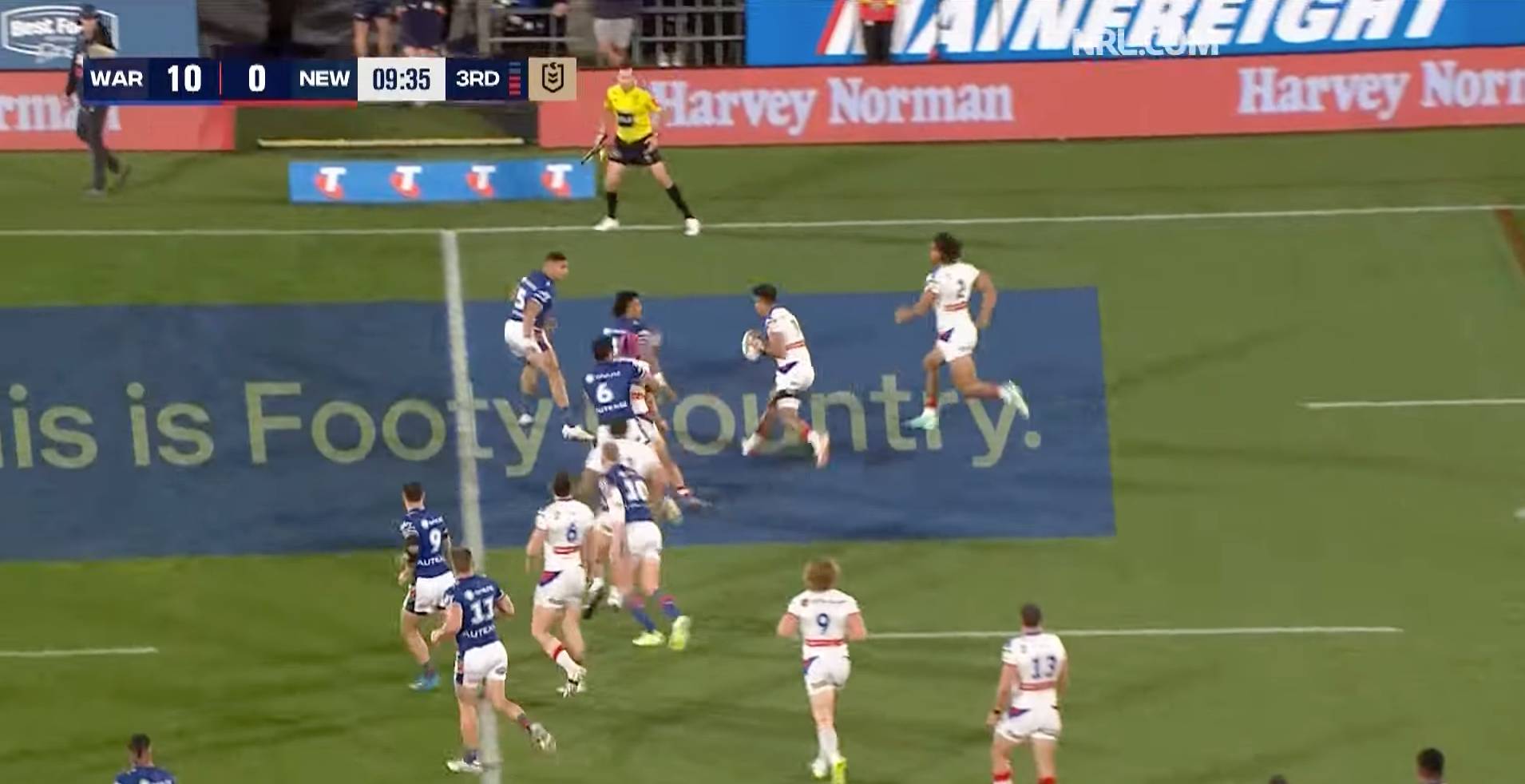Defence is largely about space, where it is left, and if the attack can get the ball there. That’s the theoretical, macro level.
The granular details of it come down to a series of minor decisions, stick or twists, that in a sport as highly systematic as rugby league, have huge domino effects down the line.
Every team has their patterns, and the best teams have multiple. In attack, there is a structure with improvisation built into it, with the defence tasked with responding to what is thrown at them.
It’s not – or at least, it shouldn’t be – a surprise. Coaches and their analysts spend the week watching, cutting tape and feeding information to their players about what they are to expect and how to deal with it.
They all know, to a micro level, what to expect. That’s on an individual level, with their opposing number, then on a cohort level – pack v pack or edge v edge – and then across the whole team, with broader play styles discussed.
Andrew Webster, the Warriors coach, is as modern and progressive as they come, and there’s no doubt that his side will go to Brisbane this Saturday night with all the detail they need.
Crucially, they will go with muscle memory too. Having overcome Newcastle last weekend, they could not have wished for a better dress rehearsal, as the Knights’ favoured patterns often look quite a lot like the Broncos.
This isn’t to say that they are one-to-one, of course, but when you roll the tape back, there’s a lot to learn – not least when working out how to deal with the Broncos’ star man, Reece Walsh.
Kalyn Ponga is about the most similar player to Walsh that there is in the NRL, and the Warriors handled him pretty well last weekend.
As individuals, both are exceptionally fast off the mark, have a pass both long and short, and are capable of making crucial decisions.
In their systems, they are also the focal point, with attacking shapes set up to exploit their specific qualities, notably in isolating defenders against their pace and giving them options to play to.
There are differences, too, notably that Ponga is a predominantly left-sided player, while Walsh does his best on the right.
That’s not exceptional, as most people are right-handed and therefore prefer to do their long passing towards the left, but Walsh has excelled in getting his right winger, Selwyn Cobbo, away.
Both Newcastle and the Broncos run do bear a lot of similarities, especially in that they seek to isolate the fullback against the defensive edge, especially on the left, which in the Warriors’ case is Marcelo Montoya, Adam Pompey and Te Maire Martin.
Newcastle’s right side, the one with Dom Young at the end of it, is one of the most potent in the NRL, and presented that trio of Wahs with a fair few challenges, which they were more than up to.

Credit: NRL
Take this example, just nine minutes in. It’s the first chance that the Knights have to put on any attack at all, and comes from one of their favourite starting spots, a centre field ruck.
They line up immediately, with Adam Elliott an option for the run, Tyson Gamble for a pass, Tyson Frizell as a lead runner and their edge of Ponga, Dane Gagai and Young set for a shift.
The Warriors play it perfectly: when the ball is played, they move up, but by the time Gamble receives the ball, they have stopped to wait.
That removes his ability to engage the line, while also telegraphing that Frizell is nothing more than a decoy, as he overruns the ball.
Thus it is shovelled along to Ponga, and though he does his best to engage with a goosestep, Martin doesn’t buy it, forcing a pass to Gagai, who flicks onto Young, who runs out of space and is forced into touch by Montoya.
By resisting the urge to jam, the Warriors force Newcastle to play in front of him, confident that they have enough grass behind them to concede a few metres, but not allow a line break.

Credit: NRL
The attack’s gambit is that one of Martin, Pompey or Montoya will bite, creating the chance for Ponga to either beat them with pace or footwork or for him to get Young on the outside, where he will be too big and fast.
To return to the idea of space, they want the space to appear either between the 1-man and the 2-man – if, for example, Pompey goes but Montoya stays – or on the outside of the 1-man – if Montoya goes but Pompey stays – or further in, if Martin doesn’t stay connected to those outside.
It happens again in the 33rd minute, with Martin doing very well to switch his attention from Gamble to the lead runner to Ponga, before Pompey completes the tackle.
Over on the other side, they pull off the same ploy. The Knights get into a quick formation on the short line, but the Warriors keep their cool and force Ponga to take the tackle, with no space allowed to Bradman Best or Greg Marzhew.
By standing still, confident in the space behind them, they remove the pass as an option and force the fullback to run when, ideally, he wouldn’t.
Later, from a scrum, the Knights set up at their widest point – Marzhew outside of Dallin Watene-Zelezniak – and look to drop Best inside, but nobody bites. It’s an easy tackle on Ponga in the end.
Here’s it done badly, in two different ways. A week before against the Raiders, Matt Frawley holds but Jack Wighton goes – Gagai runs a lead, creating doubt in the five eighth’s mind – which gives Ponga the chance to beat the centre and get around the outside.
A few weeks earlier against Souths, and on the other edge, we see the same play, with Lachlan Ilias disconnected from Campbell Graham – the fault on this occasion likely lying with the centre, who gets ahead of the ball – to allow Ponga through.
There’s a second part to this, and one that the Warriors will have to be acutely aware of come Saturday evening.
In our first example, the Knights are running this as a ‘fan’ play, which is coachspeak for inside to out. The attack wants to pin the defence narrow, condensing the line and creating space for Young around the outside.
In the Raiders example, they’re doing this too, as Young goes all the way around James Schiller, but on the other edge, they’re running it with width: look at where Greg Marzhew is. He begins outside of his winger and stays there.
This subtle positioning change is designed to open up ‘lanes’ around the inside defenders rather than on the outside. By standing further out, Marzhew forces the defence to themselves be wider.
You don’t need to see much tape of this: just close your eyes and think of a Marzhew try and a Young try. In the first, it’s likely untouched, at the corner, and in the second, it’s with one hand on the ball diving at the post.
Brisbane, perhaps more than anyone else, are masters at manipulating width.
This isn’t a secret: indeed, attacking coach Lee Briers told The Roar as much just two weeks ago about how central it was to his side’s plans.
“When we make the pitch wide, it’s about making when we’re going to attack the widest point we can attack from,” he said.
“That could be a 50, a tram, a touchline or a short side, but even then, we know it’ll be the biggest point we can go from.
“That then helps us get offloads or to play out the back because then we know there’s going to be a lot of room around. There’s numerous ways to skin a cat and we’ve found a way now that’s a sweet spot, and that’s Broncos football.”
Briers, smartly, did not go into the specifics of when these moments were – for obvious reasons – but that doesn’t stop us getting the tape out and having a look for ourselves.
Here’s two, from the same game, also against Souths. The first, they run as a fan, with Cobbo beginning his from the tramline and ending up at the corner.
Alex Johnston takes the bait and Walsh delivers the long pass, opening up where the winger just came from.
In the second, though an almost identical shape, has Cobbo much wider, starting outside the tramline and with Johnston’s attention diverted by him, Walsh goes through himself on the inside.
There are two threads that the Warriors need to bring together to make this defensive play work two weeks in a row.
Firstly, they have to make sure that they don’t bite. This wasn’t perfect last weekend – there were two occasions where their wingers went, but made the tackle and got away with it – that Webster will surely have noticed in video this week. That’s a high-wire rope against Walsh.
Martin and Johnson, who need to remember their role in this, and prove as vigilant as possible at what the attack are about to throw at them. They both have great Footy IQ and should be able to identify both the width of the wingers and the intentions of the lead runners.
Secondly, they have to set themselves up for success. One of the reasons they could employ this defensive tactic was that the game was played far enough from their own line to allow them to concede metres.
Brisbane aren’t enormously bothered about accumulating field position – they were third last in the NRL for tackles inside 20m – and will put on their attacks from deep, which is where the concentration needs to come in.
But Ponga got just seven touches inside the attacking 30m zone, one of which lead to a try for Marzhew. Obviously, it helps to keep your opponent away from your line.
It’s a tough ask for the Warriors, going in against one of the best attacking sides in the comp with the NRL’s form fullback against them.
They should take solace however, from the fact that they just did it. The Knights are the only team with a better record than Brisbane, and at a fundamental level, their attacks work on similar principles. It can be done.






























































































